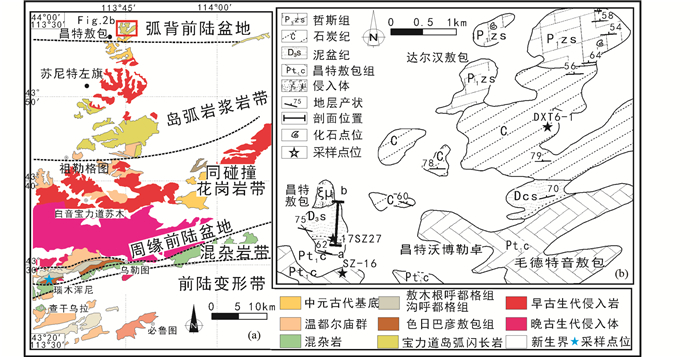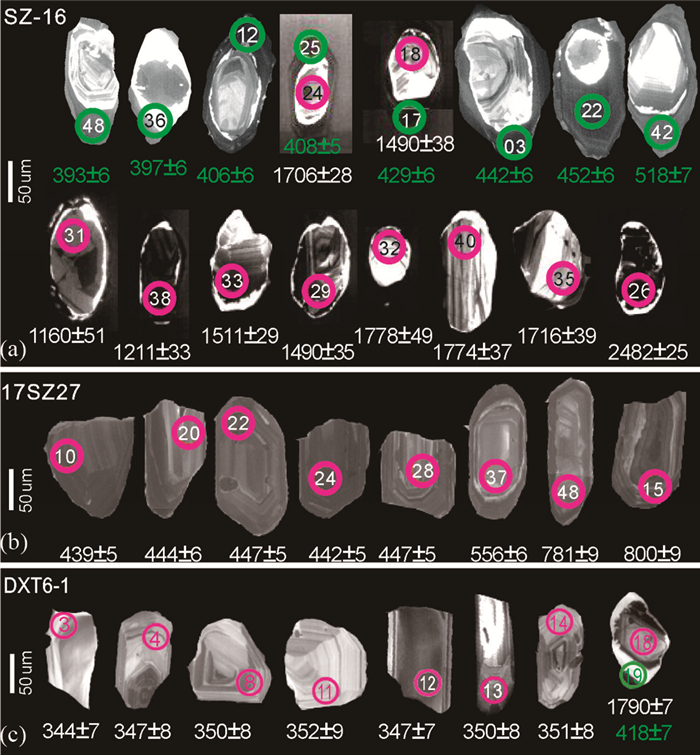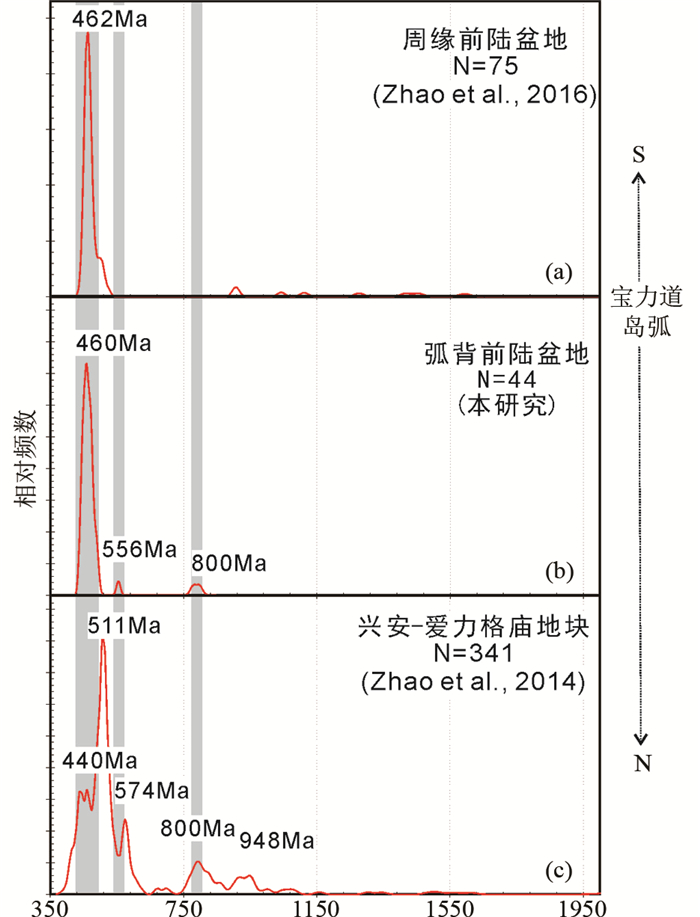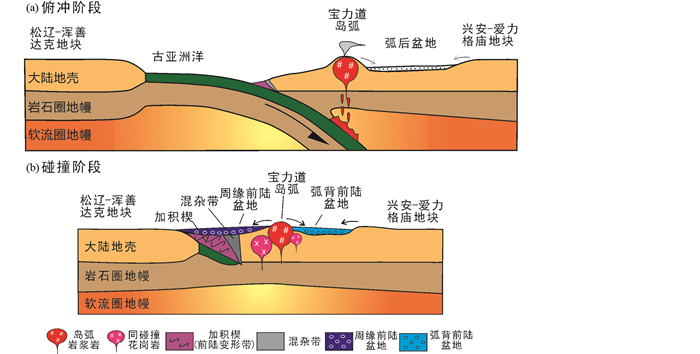2. 河北地质大学资源学院, 石家庄 050031
2. College of Resources, Hebei GEO University, Shijiazhuang 050031, China
中亚造山带位于华北板块、塔里木板块与西伯利亚板块之间,是全球最大的增生型造山带(Jahn, 2004; Kröner et al., 2014; Wilde, 2015; Xiao et al., 2015; Zhou et al., 2017)。兴蒙造山带位于中亚造山带东段,包括我国内蒙古、东北等地,是研究地壳增生和古亚洲洋闭合过程的热点地区(图 1a, Xu et al., 2015; Yang et al., 2017; Zhao et al., 2015, 2017; Zhang et al., 2017)。目前对兴蒙造山带内古亚洲洋的演化模式主要存在两种观点:一种观点认为古亚洲洋从寒武纪到二叠纪持续俯冲,直到晚二叠世-早三叠世华北板块与南蒙古板块沿着索伦-西拉木伦缝合带闭合才结束造山过程(Xiao et al., 2003, 2009, 2015; Miao et al., 2008; Eizenhöfer et al., 2014, 2015)。另一种观点认为早古生代古亚洲洋发生南、北双向俯冲,形成了南、北两条造山带。中古生代古亚洲洋完全关闭,而晚古生代发育区域伸展构造(邵济安, 1991; Xu et al., 2013; 徐备等, 2014; Zhao et al., 2016)。

|
图 1 兴蒙造山带构造位置(a)与北部造山带构造格局(b)(据方俊钦, 2015修改) Fig. 1 The location of Xing'an Mongolia Orogenic Belt (XMOB) and the North Orogenic Belt (NOB) in XMOB (modified after Fang, 2015) |
作为碰撞造山带的构造单元之一,前陆盆地是研究造山带演化的重要载体(Decelles and Giles, 1996)。根据形成原因与产出位置的不同,前陆盆地可以分为周缘前陆盆地(peripheral foreland basin)和弧背前陆盆地(retro-arc foreland basin),前者形成于造山带前缘的俯冲板块之上或陆壳与碰撞造山缝合带连接处;后者形成于大陆边缘岩浆弧内侧的仰冲板块之上(Dickinson, 1974)。深入研究不同类型前陆盆地的沉积记录能为重建造山演化过程提供重要约束(Decelles and Giles, 1996; Wang et al., 2017; 胡修棉等, 2017)。
在内蒙古中西部地区,由松辽-浑善达克地块与兴安-爱力格庙地块碰撞形成兴蒙造山带的北造山带(图 1b;徐备等, 2014),其中代表前陆盆地的上泥盆统色日巴彦敖包组陆相磨拉石建造是北造山带闭合的重要证据之一(邵济安, 1991; Xu et al., 2013)。前人报道了对苏尼特左旗南部和扎鲁特地区该磨拉石的岩石组合、地层层序与沉积环境的研究成果,并指出其属于晚泥盆世的前陆盆地(徐备和陈斌, 1997; 王弢等, 2012; Zhao et al., 2016),但未就前陆盆地的属性、分类及其与造山带的空间关系展开详细研究。
笔者在苏尼特左旗东北昌特敖包地区新识别出一套上泥盆统色日巴彦敖包组地层,通过剖面实测、锆石U-Pb定年、沉积相分析等方法,查明其地层层序、形成时代与沉积环境,并结合造山带格局推测其属于弧背前陆盆地;在此基础上,恢复了弧背前陆盆地的充填历史与形成过程。
1 区域地质概况研究区位于内蒙古中部苏尼特左旗东北部,Xu et al. (2013)按照碰撞造山带的观点将苏尼特左旗地区划分出5个二级构造单元,从南到北依次为:前陆变形带、混杂岩带、周缘前陆盆地、岛弧岩浆岩带和同碰撞花岗岩带(图 2a)。此外,根据本文研究成果,在研究区最北部新划定了弧背前陆盆地的构造单元。

|
图 2 苏尼特左旗地区造山带结构组成(a)及昌特敖包剖面位置(b)(据内蒙古自治区地质矿产局,1991;徐备和陈斌,1997) Fig. 2 The tectonic units in Sunid Zuoqi (a) and the location of the Changteaobao section (b) (modified after BGMRIM, 1991; Xu and Chen, 1997) |
前陆变形带见于研究区南部,主要由温都尔庙群组成(图 2a)。下段为桑达来音呼都格组石英岩、含铁石英岩、绿泥片岩夹透镜状大理岩,上段为哈尔哈达组绢云母石英片岩、石英岩夹碳酸盐沉积(徐备等, 1998, 2016; 李承东等, 2012)。该套地层发育两期褶皱,第一期褶皱的轴面片理S1北倾,显示褶皱总体形态向南倒转,第二期褶皱枢纽为NEE-SWW向,发育一系列北倾的逆冲断层(徐备和陈斌,1997)。
混杂岩带出露于二道井、查干乌拉到洪格尔一带(图 1b)。混杂岩基质由变质砂岩、变质火山岩和云母石英片岩组成,片理化不均一,其中碎屑锆石的最小年龄为488Ma,限定了其基质原岩形成于寒武纪末期(Xu et al., 2013)。混杂岩中的岩块以白云岩最多,其次为石英岩、石英片岩、超镁铁质和镁铁质岩石、大理岩、灰岩、砾岩和蓝片岩(徐备和陈斌,1997),其中蓝片岩的40Ar-39Ar年龄为383±13Ma,代表洋壳消减碰撞的时代(徐备等,2001)。
周缘前陆盆地沉积见于苏尼特左旗南部乌勒图-瑙木浑尼和洪格尔地区(图 2a),角度不整合覆盖于混杂岩带之上,以瑙木浑尼剖面的上泥盆统色日巴彦敖包组磨拉石建造为典型代表(图 2a)。瑙木浑尼剖面底部为紫红色复成分砾岩,砾岩中包含法门阶(374~359Ma)植物化石(Leptophloeum rhombicum, 邵济安,1991),下部为砾岩夹长石岩屑砂岩,中部为厚层泥质灰岩夹层,上部以成熟度较低的长石岩屑砂岩和粉砂岩为主,顶部为生物碎屑灰岩。色日巴彦敖包组之上为上石炭统沟呼都格组和敖木根呼都格组滨浅海陆源碎屑建造,代表陆表海正常沉积(Xu et al., 2013; Zhao et al., 2016)。
岛弧岩浆岩带出露于苏尼特左旗南和锡林浩特等地(图 1b),以苏尼特左旗南部的宝力道岛弧闪长岩为代表,岩石组合主要为闪长岩、石英闪长岩、英云闪长岩、花岗闪长岩和花岗岩,形成时代介于423~498Ma之间,被认为是古亚洲洋早期向北俯冲的产物(陈斌和徐备, 1996; Chen et al., 2000; 陈斌等, 2001; Xiao et al., 2003; 刘敦一等, 2003; 施光海等, 2003; Jian et al., 2008; 葛梦春等, 2011; Xu et al., 2013; 徐备等, 2014; Li et al., 2011, 2016)。
同碰撞花岗岩在苏尼特左旗南、北和锡林浩特一带出露(图 1b),主要由花岗闪长岩、二长花岗岩和钾长花岗岩组成,常侵入到混杂岩带、前陆变形带和岛弧岩浆带中,为中钾-高钾钙碱性系列,主要形成于中-晚古生代(423±8Ma, 424±10Ma, 石玉若等, 2005),标志着碰撞造山作用结束(陈斌和徐备, 1996; 石玉若等, 2004, 2005)。
本次研究新识别的弧背前陆盆地带见于苏尼特左旗县城以北昌特敖包附近(图 2a),可向北延伸至二连浩特地区(陈彦等, 2014; Zhao et al., 2016),为一套向南高角度倾斜的碎屑岩,包含多个砾岩-含砾砂岩-粉砂岩旋回,以冲积扇沉积为主,上部转变为火山-碎屑岩沉积(详见下述)。
2 弧背前陆盆地层序及沉积环境弧背前陆盆地地层角度不整合覆盖于前寒武纪昌特敖包组上,前人将其划为二叠纪大石寨组地层,包括第一岩性段滨岸火山泥石流-滨岸海滩沉积,第二岩性段浅海相火山喷发-沉积旋回和第三岩性段陆相-滨岸相喷发沉积,之上为二叠纪滨浅海相碎屑沉积(蒋干清等, 1995a, b;高德臻和蒋干清, 1998)。本研究实测了“大石寨组第一岩性段”地层(图 2b),并经同位素年代测定证明其属于晚泥盆世到早石炭世,根据苏尼特左旗幅地层系统(内蒙古自治区地质局第一区调队, 1965①),应将此地层归为上泥盆统色日巴彦敖包组。
① 内蒙古自治区地质局第一区调队. 1965. 1: 20万苏尼特左旗地质图说明书
2.1 地层层序昌特敖包剖面(43°56341.8″N、113°42341.8″E)共分为26层(图 3),分层描述如下:

|
图 3 苏尼特左旗东北昌特敖包剖面实测剖面图 Fig. 3 Cross section of the Changteaobao in the northeast of Sunid Zuoqi |
上覆晶屑岩屑凝灰岩、凝灰质砂岩
——————-整合——————
26.灰色中厚层粗砂岩,22.1m
25.灰色厚层钙质胶结岩屑砂岩,53.8m
24.灰绿色泥岩和粉砂岩互层,14.5m
23.厚层含砾砂岩,25.4m
22.紫红色砾岩,10.2m
21.浅灰色含砾砂岩,41.6m
20.灰色中厚层砂岩,52.8m
19.灰褐色含砾砂岩夹砾质条带,20.0m
18.紫红色砾岩,分选差,棱角-次棱角状,最大砾石直径>30cm,7.8m
17.凝灰质砂岩、含砾砂岩夹砾质条带,19.9m
16.闪长玢岩,11.3m
15.灰黄色中厚层砂岩与泥岩组成沉积旋回,泥岩中可见同沉积变形构造,56.2m
14.厚层细砂岩夹薄层凝灰质粉砂岩,29.6m
13.厚层含砾粗砂岩夹粉砂岩旋回,11.7m
12.深灰色细砂岩,发育水平层理,44.4m
11.灰绿色泥质页岩,4.0m
10.粉砂岩,风化面呈紫红色,新鲜面呈灰绿色,30.4m
9.灰绿色泥质页岩,11.7m
8.含砾砂岩夹薄层粉砂岩,18.0m
7.深灰色粉砂岩,发育斜层理,30.6m
6.灰色含砾粗砂岩,砾石成分主要为石英岩、长石石英砂岩等,23.4m
5.含砾粗砂岩夹薄层细砂岩,14.0m
4.灰色-黄灰色含砾砂岩,3.2m
3.灰色-黄灰色砂岩,发育水平层理,5.3m
2.浅灰褐色含砾粗砂岩夹砾岩,砾石包括石英岩、花岗片麻岩等,27.5m
~~~~~~ ~角度不整合~~~~~~~~
1.昌特敖包组二长变粒岩、石英岩
2.2 沉积环境昌特敖包剖面色日巴彦敖包组地层可分为2个沉积旋回(图 4):

|
图 4 昌特敖包剖面地层柱状图及野外照片 (a)条带状片麻岩;(b)砾岩;(c)含砾砂岩与细砂岩突变界面;(d)水平层理灰绿色细砂岩;(e)厚层砂岩夹泥岩,泥岩可见同生变形构造;(f)含砾砂岩-砂岩旋回;(g)凝灰质砂岩夹砾质条带;(h)砾岩 Fig. 4 Stratigraphic sequence and photographs of the Changteaobao section (a) stripped metasandstone below the unconformity; (b) conglomerate; (c) the interface between siltstone and coarse-grained sandstone; (d) horizontal bedding siltstone; (e) deformed siltstone intercalated within sandstone; (f) pebbly sandstone interlayer within sandstone; (g) conglomerate layer within tuffaceous sandstone; (h) conglomerate |
第一旋回(2~12层):下部包含多个厚层砾岩-含砾砂岩-砂岩-细砂岩构成的韵律(2~9层),韵律层内向上粒度变细,韵律间界线截然(图 4c)。砾岩中的砾石多为次棱角状、分选不好、杂基含量较高(图 4b),属近源、快速堆积的泥石流沉积;上部(10~12层)沉积粒度变细,以粉砂岩或细砂岩发育水平层理(图 4d),代表冲积扇漫流沉积。因此本旋回反映由冲积扇相扇根亚相向扇缘亚相的过渡。
第二旋回(13~26层):下部以含砾砂岩夹薄层粉砂岩、厚层砂岩-粉砂岩互层、粉砂岩-泥岩互层为主(13~16层),发育同沉积变形构造(图 4e)和水平层理(图 4f),具漫流沉积的特点,代表冲积扇扇中亚相;中部(17~24层)出现粉砂岩夹砾质条带(图 4g)和厚层紫红色砾岩,砾岩中的砾石呈次棱角-次圆状,分选较差,最大粒径超过30cm(图 4h),具有泥石流快速堆积特征,代表冲积扇扇根亚相;上部(25~26层)出现厚层钙质胶结岩屑砂岩与粗砂岩,颗粒分选较好,次圆-次棱角状,镜下可见晶屑凝灰岩岩屑与较自形的方解石(图 5d),代表干旱气候火山活动背景下的滨浅海沉积。因此,本旋回代表沉积环境由冲积扇相向火山-沉积相过渡。

|
图 5 昌特敖包剖面含砾砂岩中的碎屑颗粒成分 (a)二长花岗岩岩屑;(b)花岗闪长岩岩屑;(c)英安岩岩屑;(d)方解石胶结的晶屑凝灰岩岩屑.Qtz-石英; Pl-斜长石; Afs-碱性长石; Bio-黑云母; Cal-方解石 Fig. 5 Photomicrography of various rock fragments in Changteaobao Formation (a) rock fragment of monzogranite; (b) rock fragment of granodiorite; (c) rock fragment of dacite; (d) rock fragment of calcite cemented crystal tuff. Qtz-quartz, Pl-plagioclase; Afs-alkli feldspar; Bio-biotite; Cal-calcite |
综合以上特征,色日巴彦敖包组实测剖面以近源、快速堆积的冲积扇相沉积为主,上部逐渐过渡到干旱气候火山活动背景下的火山-沉积地层。
2.3 岩石成分为了查明昌特敖包剖面色日巴彦敖包组地层与临近大陆岛弧的关系,选择第13层(SZ-P-10)和25层(SZ-32)含砾砂岩样品进行详细岩相学研究。
SZ-P-10样品为砾状结构,块状构造,其中砾石占90%,杂基占10%。砾石分选较差,粒径在2~20mm之间。砾石呈次棱角-次圆状,砾石包括二长花岗岩(图 5a)、花岗闪长岩(图 5b)、英安岩(图 5c)、硅质岩等。填隙物多为泥质,属基底式胶结类型。
SZ-32样品为细砾结构,块状构造,其中砾石占70%,胶结物占20%,杂基占10%。砾石分选中等,粒径在2~30mm之间,以2~5mm为主。砾石呈次棱角-次圆状,主要包括英安岩、晶屑凝灰岩(图 5d)、硅质岩岩屑。填隙物多为钙质,孔隙中可见方解石结晶(图 5d)。
3 地层时代 3.1 样品采集和测试方法为了限定昌特敖包剖面各地层单元的时代,本研究采集了昌特敖包组石英岩(SZ-16, 43°56′9.4″N、113°42′45.6″E)、色日巴彦敖包组底部的长石砂岩(17SZ27, 43°56′46.3″N、113°42′42.8″E)和剖面上部的夹层火山岩(DXT6-1, 43°58′2.6″N、113°45′11.2″E)进行锆石U-Pb年代学分析(图 2b)。
SZ-16为细粒变晶结构,块状构造,主要矿物为石英(75%)和斜长石(25%),石英可见波状消光,具平衡镶嵌结构;斜长石普遍绢云母化;定名为长石石英岩(图 6a)。17SZ27为砂状结构,块状构造,主要碎屑为石英(50%)、长石(40%)、岩屑(10%),岩屑成分包括石英岩、片麻岩等,石英与岩屑颗粒呈棱角-次棱角状,分选较差;定名岩屑质长石砂岩(图 6b)。DXT6-1为斑状结构,块状构造,斑晶包括斜长石(70%)、石英(20%)和少量碱性长石(10%),斜长石多绢云母化或绿帘石化,石英斑晶呈棱角状,可见熔蚀结构,碱性长石多高岭土化;基质为霏细结构长英质矿物;定名为英安岩(图 6c)。

|
图 6 昌特敖包剖面定年样品的正交偏光镜下显微照片 Fig. 6 Microscopic photographs of U-Pb dated sample under crossed polorizer lens |
锆石挑选由河北省廊坊市诚信地质服务有限公司完成。采用常规方法将样品粉碎至300μm,经淘洗、磁选和密度分选后,在双目镜下挑选出锆石颗粒,粘贴制成环氧树脂样品靶,进行打磨、抛光使锆石露出新鲜截面。透射光、反射光和阴极发光(CL)图像的采集在北京大学造山带与地壳演化教育部重点实验室进行。锆石U-Pb同位素定年在中国地质调查局西安地质调查中心国土资源部岩浆作用成矿与找矿重点实验室完成。激光剥蚀系统为GeoLas Pro,ICP-MS为Agilent 7700X。对分析数据的离线处理采用软件Glitter 4.4 (Van Achterbergh et al., 2001)完成,详细仪器参数和测试过程可参考(李艳广等, 2015)。U-Pb同位素定年中采用锆石标准91500作外标进行同位素分馏校正。对于与分析时间有关的U-Th-Pb同位素比值漂移,利用91500的变化采用线性内插的方式进行了校正。锆石样品的U-Pb年龄谐和图绘制和年龄权重平均计算均采用Isoplot/Ex_ver 3完成(Ludwig, 2003)。测试结果见电子版附表 1。
|
|
附表 1 昌特敖包剖面锆石U-Pb分析结果 AppendixTable1 U-Pb isotopic test results of Changteaobao samples |
SZ-16样品锆石颗粒为自形-半自形,长80~150μm,宽50~100μm,锆石普遍具有核边结构(图 7a),测试的50个锆石U-Pb年龄中有44个位于谐和线上,结合锆石CL图像可将年龄数据分为2组:第一组年龄测自锆石核部(N=36),峰值年龄为1520Ma,还有1颗古元古代锆石,年龄为2482±25Ma。第二组年龄测于锆石的黑色边部,时代为393~518Ma(N=8),两个峰值年龄为402Ma和441Ma(图 8)。

|
图 7 定年样品锆石CL照片 绿圈及绿色数字代表变质年龄,紫红圈代表岩浆锆石年龄 Fig. 7 Cathodoluminescence (CL) images of selected zircons from U-Pb dated samples The circles with numbers represent U-Pb analytical sites; The ages in purple and green represent the time of magmatism and metamorphism respectively |

|
图 8 昌特敖包剖面不同层位样品定年结果 Fig. 8 U-Pb Concordia and probability diagrams of zircon ages of each sample |
17SZ27样品锆石颗粒为自形-半自形,长80~150μm,宽50~100μm,并发育良好的岩浆震荡环带(图 7b)。锆石Th/U比为0.13~2.13,说明其为岩浆成因锆石。总共选取60颗锆石进行U-Pb年代学测试,其中44颗锆石的测试结果位于谐和线上,年龄范围在439±5Ma到800±9Ma,主要年龄介于439~493Ma(N=41),其峰值年龄为460Ma。另外还有3颗新元古代锆石,分别为556±6Ma、781±9Ma和800±9Ma(图 8)。
DXT6-1样品锆石颗粒为自形-半自形,长80~100μm,宽30~100μm,普遍发育良好的岩浆震荡环带(图 7c)。锆石Th/U比为0.61~1.04,说明其为岩浆成因锆石。共选取19颗锆石进行U-Pb同位素测试,其中14颗锆石的测试结果位于谐和线上,年龄范围在337±7Ma到1790±7Ma之间,主要为一个年龄组(337±7Ma到364±8Ma),加权平均年龄为346.5±4.2Ma (N=13,MSWD=1.03,图 8c);另外还有1颗古元古代锆石,年龄为1790±7Ma。
4 讨论 4.1 形成时代和物质来源前人主要根据岩性特征、上下层位接触关系将昌特敖包剖面碎屑沉积定为二叠纪大石寨组地层(蒋干清等, 1995a, b; 高德臻和蒋干清, 1998)。本研究中实测剖面顶部火山岩夹层样品(DXT6-1)的年龄为346.5±4.2Ma,限定了色日巴彦敖包组的时代上限;而剖面下部岩屑质长石砂岩(17SZ27)最年轻碎屑锆石年龄为439±5Ma,约束了色日巴彦敖包组开始沉积的时间上限。由此可以限定色日巴彦敖包组形成于晚泥盆世-早石炭世,而非前人认为的早二叠世。
昌特敖包剖面色日巴彦敖包组底部样品(17SZ27)的碎屑锆石主要年龄在439~493Ma之间,其峰值年龄为460Ma(图 8b),与苏尼特左旗南部瑙木浑尼剖面对代表的周缘前陆盆地年龄组成近似(图 9a)。含砾砂岩样品中的颗粒包括石英(以多晶石英为主)、长石(斜长石居多,可见碱性长石)、黑云母和花岗闪长岩、二长花岗岩、晶屑凝灰岩等各类岩屑(图 5、图 6b),颗粒呈棱角-次棱角状,分选较差,结构成熟度和成分成熟度较低,表明碎屑物源区与沉积盆地距离较近。前人在苏尼特左旗南部报道了以闪长岩、石英闪长岩、英云闪长岩、花岗闪长岩和花岗岩为主的宝力道岛弧闪长岩,形成时代介于423~498Ma之间,被认为是古亚洲洋早期向北俯冲的产物(陈斌和徐备, 1996; Chen et al., 2000; 陈斌等, 2001; 刘敦一等, 2003; Jian et al., 2008)。昌特敖包剖面碎屑锆石的年龄范围与宝力道岛弧一致,同时碎屑岩岩屑成分与宝力道岛弧岩性组合相同,由此可以推断宝力道岛弧是昌特敖包剖面色日巴彦敖包组的主要物源。

|
图 9 昌特敖包剖面样品与临近地区碎屑岩样品的碎屑锆石年龄频率曲线对比 Fig. 9 Comparison of probability plots between Changteaobao and adjacent blocks (a) Seribayanaobao Formation in Naomuhunni section, south of Sunid zuoqi (Zhao et al., 2016); (b) Seribayanaobao Formation in Changteaobao section, north of Sunid Zuoqi (this study); (c) the sum up of detrital zircon ages in Xing'an-Arige Sum Block (Zhao et al., 2014) |
同时昌特敖包剖面色日巴彦敖包组长石砂岩样品中还有3颗新元古代锆石,年龄分别为556±6Ma、781±9Ma和800±9Ma (图 8b),这些锆石年龄在兴安-爱力格庙地块的弧后盆地中均有报道(图 9c, 陈彦等, 2014; 赵盼, 2014),由此可以推测色日巴彦敖包组还有部分碎屑物质来自兴安-爱力格庙地块的早古生代弧后盆地沉积。
综上,昌特敖包剖面色日巴彦敖包组地层具有南部大陆岛弧(宝力道岛弧)和北部兴安-爱力格庙地块早古生代弧后盆地的双向物质来源;其大地构造位置位于兴蒙造山带北造山带前陆变形带、混杂岩带、周缘前陆盆地、岛弧岩浆岩带以北(图 2),由此可以推断昌特敖包剖面为弧背前陆盆地。
4.2 弧背前陆盆地沉积速率的对比及其意义为了定性描述前陆盆地的沉积过程,在不考虑去压实校正、负载校正、海平面校正等因素情况下,可将地层实测厚度除以其年代跨度而得到地层形成速率(Thickness/Duration,本文称为T/D比)。
昌特敖包剖面色日巴彦敖包组角度不整合于下伏地层之上,底部砂岩中发现法门阶植物化石(Leptophloeum rhombicum, 邵济安, 1991)。受限于生物地层标志的分辨率,本文取法门阶(374~359Ma)年龄中值367Ma大致代表色日巴彦敖包组底部年龄。昌特剖面顶部火山岩样品年龄(DXT6-1: 346.5±4.2Ma)代表色日巴彦敖包组顶部年龄(图 10)。因此,可以计算出昌特敖包剖面T/D比为(164m+425m)/(367Ma~346.5Ma)=0.029mm/yr。

|
图 10 昌特敖包剖面弧背前陆盆地T/D比 Fig. 10 Thickness/Duration ratio of retro-arc foreland basins in Changteaobao area |
研究表明典型的陆内造山带的前陆盆地如库车前陆盆地,其三叠纪到侏罗纪地层的T/D比为0.021~0.073mm/yr(张明山等,1996),与本地区同为一个数量级。而在典型的碰撞造山带,前陆盆地的T/D比为10-1~100mm/yr(如:印度中新世Siwalik群:0.38mm/yr, Meigs et al., 1995;印度上新-更新世Dehra Dun和Subathu盆地:0.70mm/yr,0.39mm/yr, Kumar et al., 2003;伊朗北部新生代晚期Eyvanekey剖面:0.309~2.17mm/yr,平均0.65mm/yr,Ballato et al., 2008),高于陆内造山带一个数量级。
不同前陆盆地T/D比的差异可能与造山带性质有关,喜马拉雅造山带属碰撞型造山带,故构造作用强烈,剥蚀及沉积速率较大;而兴蒙造山带属加积型造山带,具有软碰撞、弱造山的特点(任纪舜等, 1999),因此剥蚀及沉积速率较小。当然盆地充填速率的影响因素较多(Decelles and Giles, 1996; Xie and Paul, 2009),昌特敖包剖面沉积速率可以作为兴蒙造山带同时期类似盆地充填过程对比的标尺。
4.3 北造山带弧背前陆盆地的形成根据本文新厘定的弧背前陆盆地和前人发表的研究成果,可以反演兴蒙造山带弧背前陆盆地的形成过程:
俯冲阶段:490~420Ma,松辽-浑善达克地块北缘的古亚洲洋(温都尔庙群)向北俯冲至兴安-爱力格庙地块之下,在兴安-爱力格庙地块南缘(如苏尼特左旗南部地区)形成宝力道岛弧带,岛弧带以北发育弧后盆地(图 11a)。

|
图 11 兴蒙造山带北造山带弧背前陆盆地形成过程 Fig. 11 Schematic evolutionary model of retro-arc foreland basin in the North Orogenic Belt of XMOB |
碰撞阶段:晚泥盆世古亚洲洋俯冲结束,松辽-浑善达克地块与兴安-爱力格庙地块开始碰撞,北造山带形成并遭受剥蚀,在加积楔和混杂带部位上叠了周缘前陆盆地,而早期的弧后盆地转变为弧背前陆盆地,两者共同接受磨拉石沉积(图 11b)。
5 结论(1) 昌特敖包剖面碎屑沉积属上泥盆统色日巴彦敖包组,而非前人认为的二叠纪大石寨组,其碎屑物质主要来自南部的宝力道岛弧与北部兴安-爱力格庙地块。
(2) 沉积环境分析表明昌特敖包剖面色日巴彦敖包组以冲积扇相沉积为主,后期逐渐过渡到干旱气候火山活动背景下的滨浅海相沉积。
(3) 兴蒙造山带北造山带除前人划定的前陆变形带、混杂岩带、周缘前陆盆地、岛弧岩浆岩带等二级构造单元之外,在苏尼特左旗北部还存在晚泥盆世弧背前陆盆地。
致谢 北京大学颜林杰、徐严、栗进和河北地质大学王智慧、田英杰、唐军、翟鹏、万语在野外工作和室内资料整理中给予了帮助; 两位审稿人提出了许多建设性意见;在此一并致谢!本文属于IGCP662项目的系列出版物。
Ballato P, Nowaczyk NR, Landgraf A, Strecker MR, Friedrich A and Tabatabaei SH. 2008. Tectonic control on sedimentary facies pattern and sediment accumulation rates in the Miocene foreland basin of the southern Alborz Mountains, northern Iran. Tectonics, 27(6): TC6001. |
Chen B and Xu B. 1996. The main Characteristics and tectonic implications of two kinds of Paleozoic granitoids in Sunidzuoqi, Central Inner Mongolia. Acta Petrologica Sinica, 12(4): 546-561. |
Chen B, Jahn BM, Wilde S and Xu B. 2000. Two contrasting paleozoic magmatic belts in northern Inner Mongolia, China:Petrogenesis and tectonic implications. Tectonophysics, 328(1-2): 157-182. DOI:10.1016/S0040-1951(00)00182-7 |
Chen B, Zhao GC and Wilde S. 2001. Subduction-and collision-related granitoids from southern Sonidzuoqi, Inner Mongolia:Isotopic ages and tectonic implications. Geological Review, 47(4): 361-367. |
Chen Y, Zhang ZC, Li K, Luo ZW, Tang WH and Li QG. 2014. Provenance analysis of the Ordovician sandstones in northern Sonid Left Banner area of Inner Mongolia and its geological significance. Geological Bulletin of China, 33(9): 1308-1319. |
Decelles PG and Giles KA. 1996. Foreland basin systems. Basin Research, 8(2): 105-123. DOI:10.1046/j.1365-2117.1996.01491.x |
Dickinson WR. 1974. Plate tectonics and sedimentation. In:Dickinson WR (ed.). Tectonics and Sedimentation. Tulsa:SEPM Special Publication, 22:1-27
|
Eizenhöfer PR, Zhao GC, Zhang J and Sun M. 2014. Final closure of the Paleo-Asian Ocean along the Solonker Suture Zone:Constraints from geochronological and geochemical data of Permian volcanic and sedimentary rocks. Tectonics, 33(4): 441-463. DOI:10.1002/2013TC003357 |
Eizenhöfer PR, Zhao GC, Zhang J, Han YG, Hou WZ, Liu DX and Wang B. 2015. Geochemical characteristics of the Permian basins and their provenances across the Solonker Suture Zone:Assessment of net crustal growth during the closure of the Palaeo-Asian Ocean. Lithos, 224-225: 240-255. DOI:10.1016/j.lithos.2015.03.012 |
Fang JQ. 2015. The Paleozoic tectonic evolution of Xing'an-Mongolia Orogenic Belt in central-eastern Inner Mongolia. Ph. D. Dissertation. Beijing: Peking University.
|
Gao DZ and Jiang GQ. 1998. Revision of the stratigraphic division of the Permian and tectonic evolution in the Sonid Left Banner, Inner Mongolia. Regional Geology of China, 17(4): 401-411. |
Ge MC, Zhou WX, Yu Y, Sun JJ, Bao JQ and Wang SH. 2011. Dissolution and supracrustal rocks dating of Xilin Gol complex, Inner Mongolia, China. Earth Science Frontiers, 18(5): 182-195. |
Hu XM, Wang JG, An W, Garzanti E and Li J. 2017. Constraining the timing of the India-Asia continental collision by the sedimentary record. Science China (Earth Sciences), 60(4): 603-625. DOI:10.1007/s11430-016-9003-6 |
Bureau of Geology and Mineral Resources of Inner Mongolian Autonomous Region (BGMRIM). 1991. Regional Geology of Inner Mongolian Autonomous Region. Beijing: Geological Publishing House.
|
Jahn BM. 2004. The Central Asian Orogenic Belt and growth of the continental crust in the Phanerozoic. In: Fitton JG, Mahoney JJ, Wallace PJ and Saunders AD (eds.). Origin and Evolution of the Ontong Java Plateau. Geological Society, London, Special Publications, 226: 73-100
|
Jian P, Liu DY, Kröner A, Windley BF, Shi YR, Zhang FQ, Shi GH, Miao LC, Zhang W, Zhang Q, Zhang L and Ren JS. 2008. Time scale of an early to mid-Paleozoic orogenic cycle of the long-lived Central Asian Orogenic Belt, Inner Mongolia of China:Implications for continental growth. Lithos, 101(3-4): 233-259. DOI:10.1016/j.lithos.2007.07.005 |
Jiang GQ, Xu YK, Zhao GQ, Luo F, Xiao RG and Luo ZH. 1995a. Evolution of process-facies and environment-facies sequence of Permian Dashizhai Formation in Sonid Zuoqi area, Inner Mongolia. Geoscience, 9(2): 170-178. |
Jiang GQ, Zhang WJ, Xiao RG, Luo ZH, Li SJ and Gao DZ. 1995b. Subdivision and correlation of Permian strata in Sonid Zuoqi area, Inner Mongolia. Geoscience, 9(2): 149-161. |
Kröner A, Kovach V, Belousova E, Hegner E, Armstrong R, Dolgopolova A, Seltmann R, Alexeiev DV, Hoffmann JE, Wong J, Sun M, Cai K, Wang T, Tong Y, Wilde SA, Degtyarev KE and Rytsk E. 2014. Reassessment of continental growth during the accretionary history of the Central Asian Orogenic Belt. Gondwana Research, 25(1): 103-125. DOI:10.1016/j.gr.2012.12.023 |
Kumar R, Ghosh SK, Mazari RK and Sangode SJ. 2003. Tectonic impact on the fluvial deposits of Plio-Pleistocene Himalayan foreland basin, India. Sedimentary Geology, 158(3-4): 209-234. DOI:10.1016/S0037-0738(02)00267-1 |
Li CD, Ran H, Zhao LG, Wang HC, Zhang K, Xu YW, Gu YC and Zhang YQ. 2012. LA-MC-ICPMS U-Pb geochronology of zircons from the Wenduermiao Group and its tectonic significance. Acta Petrologica Sinica, 28(11): 3705-3714. |
Li S, Wilde SA, Wang T, Xiao WJ and Guo QQ. 2016. Latest Early Permian granitic magmatism in southern Inner Mongolia, China:Implications for the tectonic evolution of the southeastern Central Asian Orogenic Belt. Gondwana Research, 29(1): 168-180. DOI:10.1016/j.gr.2014.11.006 |
Li YG, Wang SS, Liu MW, Meng E, Wei XY, Zhao HB and Jin MQ. 2015. U-Pb dating study of baddeleyite by LA-ICP-MS:Technique and application. Acta Geologica Sinica, 89(12): 2400-2418. |
Li YL, Zhou HW, Brouwer FM, Wijbrans JR, Zhong ZQ and Liu HF. 2011. Tectonic significance of the Xilin Gol complex, Inner Mongolia, China:Petrological, geochemical and U-Pb zircon age constraints. Journal of Asian Earth Sciences, 42(5): 1018-1029. DOI:10.1016/j.jseaes.2010.09.009 |
Liu DY, Jian P, Zhang Q, Zhang FQ, Shi YR, Shi GH, Zhang LQ and Tao H. 2003. SHRIMP dating of adakites in the Tulingkai ophiolite, Inner Mongolia:Evidence for the Early Paleozoic subduction. Acta Geologica Sinica, 77(3): 317-327. |
Ludwig KR. 2003. ISOPLOT 3.00:A Geochronological Toolkit for Microsoft Excel. California: Berkeley Geochronology Center.
|
Meigs AJ, Burbank DW and Beck RA. 1995. Middle-Late Miocene (>10Ma) formation of the Main boundary thrust in the western Himalaya. Geology, 23(5): 423-426. DOI:10.1130/0091-7613(1995)023<0423:MLMMFO>2.3.CO;2 |
Miao LC, Fan WM, Liu DY, Zhang FQ, Shi YR and Guo F. 2008. Geochronology and geochemistry of the Hegenshan ophiolitic complex:Implications for late-stage tectonic evolution of the Inner Mongolia-Daxinganling Orogenic Belt, China. Journal of Asian Earth Sciences, 32(5-6): 348-370. DOI:10.1016/j.jseaes.2007.11.005 |
Ren JS, Niu BG and Liu ZG. 1999. Soft collision, superposition orogeny and polycyclic suturing. Earth Science Frontiers, 6(3): 85-93. |
Shao JA. 1991. Crustal Evolution in the Middle Part of the Northern Margin of the Sino-Korean Plate. Beijing: Peking University Publishing House.
|
Shi GH, Liu DY, Zhang Q, Zhang FQ, Jian P, Miao LC, Shi YR and Tao H. 2003. SHRIMP U-Pb zircon geochronology and its implications on the Xilin Gol Complex, Inner Mongolia, China. Chinese Science Bulletin, 48(24): 2742-2748. DOI:10.1007/BF02901768 |
Shi YR, Liu DY, Zhang Q, Jian P, Zhang FQ, Miao LC, Shi GH, Zhang LQ and Tao H. 2004. SHRIMP dating of diorites and granites in southern Suzuoqi, Inner Mongolia. Acta Geologica Sinica, 78(6): 789-799. |
Shi YR, Liu DY, Jian P, Zhang Q, Zhang FQ, Miao LC, Shi GH, Zhang LQ and Tao H. 2005. Zircon SHRIMP dating of K-rich granites in Sonid Zuoqi, central Inner Mongolia. Geological Bulletin of China, 24(5): 424-428. |
van Achterbergh E, Ryan CG, Jackson SE and Griffin WL. 2001. Data reduction software for LA-ICP-MS. In: Sylvester PJ (ed.). Laser-Ablation-ICPMS in the Earth Sciences: Principles and Applications. Mineralogical Society of Canada Short Course Series, 29: 239-243
|
Wang JG, Hu XM, Garzanti E, An W and Liu XC. 2017. The birth of the Xigaze forearc basin in southern Tibet. Earth and Planetary Science Letters, 465: 38-47. DOI:10.1016/j.epsl.2017.02.036 |
Wang T, Lu YJ, Zhang PC and Zhi XG. 2012. Revision of the Seribayanaobao formation in the north of Jarud Qi, Inner Mongolia. Geology and Resources, 21(2): 200-204. |
Wilde SA. 2015. Final amalgamation of the Central Asian Orogenic Belt in NE China:Paleo-Asian Ocean closure versus Paleo-Pacific plate subduction:A review of the evidence. Tectonophysics, 662: 345-362. DOI:10.1016/j.tecto.2015.05.006 |
Xiao WJ, Windley BF, Hao J and Zhai MG. 2003. Accretion leading to collision and the Permian Solonker suture, Inner Mongolia, China:Termination of the Central Asian orogenic belt. Tectonics, 22(6): 1069. |
Xiao WJ, Windley BF, Huang BC, Han CM, Yuan C, Chen HL, Sun M, Sun S and Li JL. 2009. End-Permian to Mid-Triassic termination of the accretionary processes of the southern Altaids:Implications for the geodynamic evolution, Phanerozoic continental growth, and metallogeny of Central Asia. International Journal of Earth Sciences, 98(6): 1189-1217. DOI:10.1007/s00531-008-0407-z |
Xiao WJ, Windley BF, Sun S, Li JL, Huang BC, Han CM, Yuan C, Sun M and Chen HL. 2015. A tale of amalgamation of three Permo-Triassic collage systems in Central Asia:Oroclines, sutures, and terminal accretion. Annual Review of Earth and Planetary Sciences, 43(1): 477-507. DOI:10.1146/annurev-earth-060614-105254 |
Xie XY and Paul LH. 2009. Plate tectonics and basin subsidence history. GSA Bulletin, 121(1-2): 55-64. |
Xu B and Chen B. 1997. Framework and evolution of the Middle Paleozoic orogenic belt between Siberian and North China plates in northern Inner Mongolia. Science in China (Series D), 40(5): 463-469. DOI:10.1007/BF02877610 |
Xu B. 1998. Sedimentary environment and tectonic significance of the north belt of the Ondor Sum Group in Inner Mongolia. Scientia Geologica Sinica, 33(4): 406-411. |
Xu B, Charvet J and Zhang FQ. 2001. Primary study on petrology and geochrononology of blueschists in Sunite Zuoqi, northern Inner Mongolia. Chinese Journal of Geology, 36(4): 424-434. |
Xu B, Charvet J, Chen Y, Zhao P and Shi GZ. 2013. Middle Paleozoic convergent orogenic belts in western Inner Mongolia (China):Framework, kinematics, geochronology and implications for tectonic evolution of the Central Asian Orogenic Belt. Gondwana Research, 23(4): 1342-1364. DOI:10.1016/j.gr.2012.05.015 |
Xu B, Zhao P, Bao QZ, Zhou YH, Wang YY and Luo ZW. 2014. Preliminary study on the pre-Mesozoic tectonic unit division of the Xing-Meng Orogenic Belt (XMOB). Acta Petrologica Sinca, 30(7): 1841-1857. |
Xu B, Zhao P, Wang YY, Liao W, Luo ZW, Bao QZ and Zhou YH. 2015. The pre-Devonian tectonic framework of Xing'an-Mongolia orogenic belt (XMOB) in North China. Journal of Asian Earth Sciences, 97: 183-196. DOI:10.1016/j.jseaes.2014.07.020 |
Xu B, Xu Y, Li J and Li QS. 2016. Age of the Ondor Sum group in western Inner Mongolia and its position in the Central Asia Orogenic Belt. Earth Science Frontiers, 23(6): 120-127. |
Yang JF, Zhang ZC, Chen Y, Yu HF and Qian XY. 2017. Ages and origin of felsic rocks from the eastern Erenhot ophiolitic complex, southeastern Central Asian Orogenic Belt, Inner Mongolia China. Journal of Asian Earth Sciences, 144: 126-140. DOI:10.1016/j.jseaes.2016.12.049 |
Zhang MS, Qian XL and Li MS. 1996. A Quantitative discussion to the relationship between Thrusting of orogenic belt and subsidence and sedimentation of foreland basin:Kuche Intracontinental foreland basin as an example. Acta Scicentiarum Naturalum Universitis Pekinesis, 32(2): 188-198. |
Zhang ZC, Chen Y, Li K, Li JF, Yang JF and Qian XY. 2017. Geochronology and geochemistry of Permian bimodal volcanic rocks from central Inner Mongolia, China:Implications for the Late Palaeozoic tectonic evolution of the south-eastern Central Asian Orogenic Belt. Journal of Asian Earth Sciences, 135: 370-389. DOI:10.1016/j.jseaes.2017.01.012 |
Zhao P. 2014. The Late Palaeozoic tectonic evolution of Central Asian Orogenic Belt in central-eastern Inner Mongolia. Ph. D. Dissertation. Beijing: Peking University.
|
Zhao P, Fang JQ, Xu B, Chen Y and Faure M. 2014. Early Paleozoic tectonic evolution of the Xing-Meng Orogenic Belt:Constraints from detrital zircon geochronology of western Erguna-Xing'an Block, North China. Journal of Asian Earth Sciences, 95(38): 136-146. |
Zhao P, Faure M, Chen Y, Shi GZ and Xu B. 2015. A new Triassic shortening-extrusion tectonic model for Central-Eastern Asia:Structural, geochronological and paleomagnetic investigations in the Xilamulun Fault (North China). Earth and Planetary Science Letters, 426: 46-57. DOI:10.1016/j.epsl.2015.06.011 |
Zhao P, Xu B, Tong QL, Chen Y and Faure M. 2016. Sedimentological and geochronological constraints on the Carboniferous evolution of central Inner Mongolia, southeastern Central Asian Orogenic Belt:Inland sea deposition in a post-orogenic setting. Gondwana Research, 31: 253-270. DOI:10.1016/j.gr.2015.01.010 |
Zhao P, Xu B and Zhang CH. 2017. A rift system in southeastern Central Asian Orogenic Belt:Constraint from sedimentological, geochronological and geochemical investigations of the Late Carboniferous-Early Permian strata in northern Inner Mongolia (China). Gondwana Research, 47: 342-357. DOI:10.1016/j.gr.2016.06.013 |
Zhou JB, Wilde SA, Zhao GC and Han J. 2017. Nature and assembly of microcontinental blocks within the Paleo-Asian Ocean. Earth-Science Reviews. DOI:10.1016/j.earscirev.2017.01.012 |
陈斌, 徐备. 1996. 内蒙古苏左旗地区古生代两类花岗岩类的基本特征和构造意义. 岩石学报, 12(4): 546-561. DOI:10.3321/j.issn:1000-0569.1996.04.004 |
陈斌, 赵国春, Wilde S. 2001. 内蒙古苏尼特左旗南两类花岗岩同位素年代学及其构造意义. 地质论评, 47(4): 361-367. DOI:10.3321/j.issn:0371-5736.2001.04.005 |
陈彦, 张志诚, 李可, 罗志文, 汤文豪, 李秋根. 2014. 内蒙古苏尼特左旗北奥陶系砂岩物源分析及其地质意义. 地质通报, 33(9): 1308-1319. DOI:10.3969/j.issn.1671-2552.2014.09.005 |
方俊钦. 2015. 内蒙古中东部兴蒙造山带古生代构造演化.博士学位论文. 北京: 北京大学.
|
高德臻, 蒋干清. 1998. 内蒙古苏尼特左旗二叠系的重新厘定及大地构造演化分析. 中国区域地质, 17(4): 401-411. |
葛梦春, 周文孝, 于洋, 孙俊俊, 鲍建泉, 王世海. 2011. 内蒙古锡林郭勒杂岩解体及表壳岩系年代确定. 地学前缘, 18(5): 182-195. |
胡修棉, 王建刚, 安慰, Eduardo G, 李娟. 2017. 利用沉积记录精确约束印度-亚洲大陆碰撞时间与过程. 中国科学(地球科学), 47(3): 261-283. |
蒋干清, 徐元恺, 赵国春, 罗飞, 肖荣阁, 罗照华. 1995a. 内蒙古苏尼特左旗下二叠统大石寨组作用相与环境相序列演化. 现代地质, 9(2): 170-178. |
蒋干清, 张维杰, 肖荣阁, 罗照华, 李述靖, 高德臻. 1995b. 内蒙古苏尼特左旗地区二叠纪地层的划分与对比. 现代地质, 9(2): 149-161. |
李承东, 冉皡, 赵利刚, 王慧初, 张阔, 许雅雯, 谷永昌, 张永清. 2012. 温都尔庙群锆石的LA-MC-ICPMS U-Pb年龄及构造意义. 岩石学报, 28(11): 3705-3714. |
李艳广, 汪双双, 刘民武, 蒙恩, 魏小燕, 赵慧博, 靳梦琪. 2015. 斜锆石LA-ICP-MS U-Pb定年方法及应用. 地质学报, 89(12): 2400-2418. DOI:10.3969/j.issn.0001-5717.2015.12.015 |
刘敦一, 简平, 张旗, 张福勤, 石玉若, 施光海, 张履桥, 陶华. 2003. 内蒙古图林凯蛇绿岩中埃达克岩SHRIMP测年:早古生代洋壳消减的证据. 地质学报, 77(3): 317-327. DOI:10.3321/j.issn:0001-5717.2003.03.004 |
内蒙古自治区地质矿产局. 1991. 内蒙古自治区区域地质志. 北京: 地质出版社.
|
任纪舜, 牛宝贵, 刘志刚. 1999. 软碰撞、叠覆造山和多旋回缝合作用. 地学前缘, 6(3): 85-93. DOI:10.3321/j.issn:1005-2321.1999.03.008 |
邵济安. 1991. 中朝板块北缘中段地壳演化. 北京: 北京大学出版社.
|
施光海, 刘敦一, 张旗, 张福勤, 简平, 苗来成, 石玉若, 陶华. 2003. 中国内蒙古锡林郭勒杂岩SHRIMP锆石U-Pb年代学及其意义. 科学通报, 48(20): 2187-2192. DOI:10.3321/j.issn:0023-074X.2003.20.017 |
石玉若, 刘敦一, 张旗, 简平, 张福勤, 苗来成, 施光海, 张履桥, 陶华. 2004. 内蒙古苏左旗地区闪长-花岗岩类SHRIMP年代学. 地质学报, 78(6): 789-799. DOI:10.3321/j.issn:0001-5717.2004.06.009 |
石玉若, 刘敦一, 简平, 张旗, 张福勤, 苗来成, 施光海, 张履桥, 陶华. 2005. 内蒙古中部苏尼特左旗富钾花岗岩锆石SHRIMP U-Pb年龄. 地质通报, 24(5): 424-428. DOI:10.3969/j.issn.1671-2552.2005.05.006 |
王弢, 路跃军, 章培春, 智学功. 2012. 内蒙古扎鲁特旗北色日巴彦敖包组的厘定. 地质与资源, 21(2): 200-204. DOI:10.3969/j.issn.1671-1947.2012.02.004 |
徐备, 陈斌. 1997. 内蒙古北部华北板块与西伯利亚板块之间中古生代造山带的结构及演化. 中国科学(D辑), 27(3): 227-232. |
徐备. 1998. 内蒙古北部温都尔庙群北带沉积环境及构造意义. 地质科学, 33(4): 406-411. DOI:10.3321/j.issn:0563-5020.1998.04.003 |
徐备, Charvet J, 张福勤. 2001. 内蒙古北部苏尼特左旗蓝片岩岩石学和年代学研究. 地质科学, 36(4): 424-434. DOI:10.3321/j.issn:0563-5020.2001.04.005 |
徐备, 赵盼, 鲍庆中, 周永恒, 王炎阳, 罗志文. 2014. 兴蒙造山带前中生代构造单元划分初探. 岩石学报, 30(7): 1841-1857. |
徐备, 徐严, 栗进, 李群生. 2016. 内蒙古西部温都尔庙群的时代及其在中亚造山带中的位置. 地学前缘, 23(6): 120-127. |
张明山, 钱祥麟, 李茂松. 1996. 造山带逆冲与前陆盆地沉降和沉积平衡关系的定量讨论——以库车陆内前陆盆地为例. 北京大学学报(自然科学版), 32(2): 188-198. DOI:10.3321/j.issn:0479-8023.1996.02.010 |
赵盼. 2014. 内蒙古中东部中亚造山带晚古生代构造演化.博士学位论文. 北京: 北京大学.
|
 2018, Vol. 34
2018, Vol. 34








